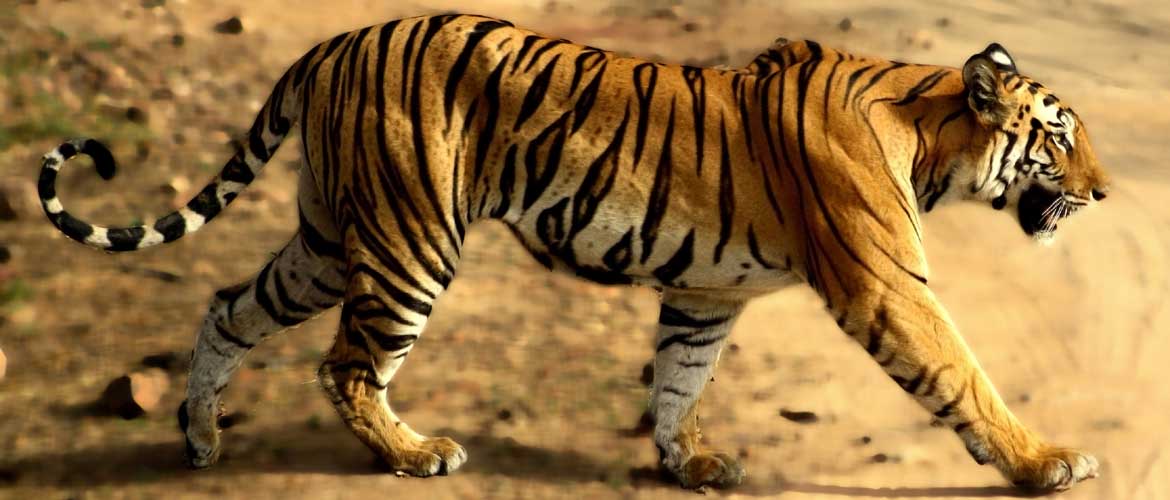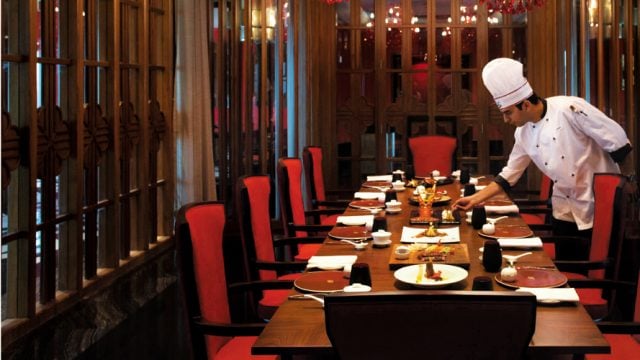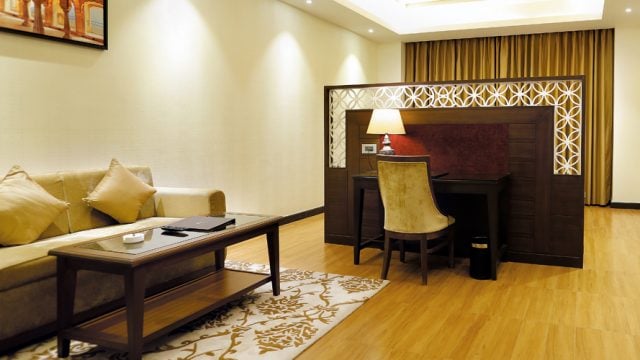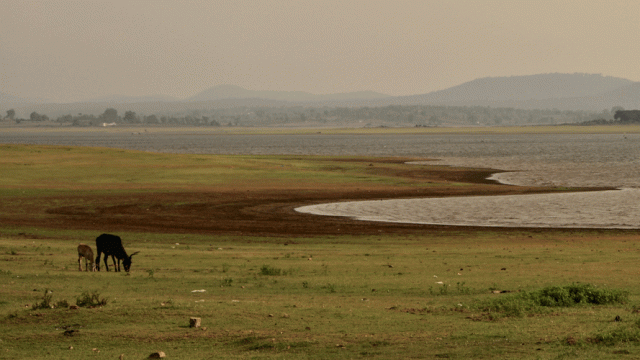Bandhavgarh National Park is a small tract of protected forest that was once the shikargarh
Entry Indians ₹5,000; Foreigners ₹6,500 (per vehicle, per round, up to six pax, guide and vehicle fee) Entry into the Tala zone Indians ₹5,500; Foreigners ₹8,500 Timings 6.00–10.00am & 3.00–5.30pm

THINGS TO SEE AND DO
Jeep Safari
Do make the most of these twice-daily jeep safaris here. Advance booking is required. Most hotels, however, will include park-related fees in their prices, so check with your hotel about the safari. Elephant safaris have been discontinued now.
The Bandhavgarh Gaur
This magnificent species became extinct here in 1998 but was reintroduced in 2011 through translocation of 50 animals from Kanha. There are around 80 gaur. The number is growing despite regular predation by tigers.
Caves
In the northern area of the park, there are more than 30 sandstone caves bearing Brahmi inscriptions, and drawings dating back to the 1st century BCE. You can explore these beautiful caves, however, note that sometimes there is a steel grille across the cave entrance.
Bandhavgarh Fort
The 2,000-year-old Bandhavgarh Fort sits atop the sheer cliffs and escarpments of the Bandhavgarh Hill, from which the park gets its name. The fort is now part of the reserve forest. It’s the only area inside the park where you are allowed to travel on foot.

You will have to undertake a tough half-hour hike to get here. The road will take you up to the Shesh Shaiya, a large statue of Vishnu reclining on a seven-hooded serpent. It is located in a green pool of water that is also the source of the Charanganga River.
Along the way, a little off the main path, you will see statues of the 10 avatars of Vishnu. Also look out for the three beautiful, small 12th century temples. At the top are the ruins of the palaces of the Baghel royals, the last of whom left the fort in 1935. The temple adjoining the palace is a living monument; the priest lives there alone and is said to be the only man authorised to walk through the park to get supplies.
The view from here is absolutely spectacular as it overlooks the nesting site of dozens of vultures as well as the flight plans of grey hornbills. It is the perfect setting for birdwatchers.
Baghel Museum
The Baghel Museum, located near Tala village, is home to Mohan, the white tiger cub captured by Maharaja Martand Singh in 1951, stuffed and mounted, besides royal artefacts of the maharaja’s family.
After independence, Singh devoted all his energies towards animal conservation, with particular focus on the tiger. He played a major role in the establishment of the Bandhavgarh National Park.
Entry Free Timings 10.00am–4.00pm
WHERE TO STAY
Most hotels are around Tala, near the park entrance on the Umaria-Rewa Highway. Although your hotel will provide you with pretty much everything you need, other supplies are available in town. There is a fuel pump here, which saves you the long trip to Umaria. Make sure that you have plenty of reserve supply, however, as fuel supply can be a bit erratic.
Tree House Hideaway (Cell: 0880063771; Tariff: ₹18,000 with meals) is a group of five treehouses with all amenities. The pricey, ethnic but specialised luxury of Mahua Kothi (Tel: 1800111825, Mumbai Tel: 022-66011825; Tariff: ₹30,000–48,500) run by the Taj Group doesn’t come cheap and is patronised by foreign tourists.
The cosy Nature Heritage Resort (Tel: 07627-265351, Cell: 09425331200; Tariff: ₹6,500–7,500, with meals) has large rooms located around an open-air dining hut and a few campfire pits.
The Mahua Tiger Resort (Cell: 07566656456, 08889348899; Tariff: ₹6,000–8,400, with meals) is a charming option with deluxe cottages and Swiss tents on offer.
The Tiger’s Den Resort (Delhi Tel: 011-27570446, Cell: 0965001274; Tariff: ₹7,500–8,500, with meals) has 22 luxury cottages with elegant little patios set in a lawn, and 24-hour power backup. A jeep safari for four costs about ₹5,000–6,000. One of their guides, Raghvendra Singh, claims a 96 per cent success rate in tiger tracking. Bagh Sarai Resort (Cell: 09818680958; Tariff: ₹6,500, with meals) offers six cottages. It arranges basic facilities such as safaris, jungle walks and treks. The luxurious Bandhavgarh Jungle Resort (Delhi Tel: 011-26853760/ 8656; Tariff: ₹8,500–10,500, with meals) has 18 rooms on offer. Along with arranging safaris, this resort also provides a nature library and a solar water treatment plant. Jungle Mantra (Cell: 09407582955, 07489897526; Tariff: ₹13,495, with meals), has eight cottages along with nature walks and tribal village visits.
Kings Lodge (Gurgaon Tel: 0124-2970497, Cell: 08800637711; Tariff: ₹13,500, with meals) has ten cottage rooms and eight cottage rooms with modern bathrooms.
Monsoon Forest (Cell: 09752878402; Tariff: ₹7,500, with meals) is a quiet retreat offering yoga and meditation programmes, amongst other facilities, and comfortable accommodation. MP Tourism’s White Tiger Forest Lodge (Tel: 265366, 265406; Tariff: ₹4,290–5,390, with meals) has a sprawling garden, a swimming pool and a spa.
WHERE TO EAT
It is a good idea to have the primary meals at your hotel or any of the nearby resorts and lodges, since there are limited food options. It is recommended that you carry food when out on a trek or excursion.
FAST FACTS
When to go October–March, when the weather is pleasant
Wildlife/ Tourist offices
Field Director, Bandhavgarh Tiger Reserve, Umaria, Tel: 07653-222214, W mpforest.org
White Tiger Forest Lodge, Telfax: 265366/ 406, W mptourism.com
STD code Tala 07627 Umaria 07653
GETTING THERE
Air Nearest airport: Jabalpur (193km/ 4hrs), connected by flights with Delhi, Mumbai and Bhopal. Taxi fare ₹5,500–6,000 approximately
Rail Nearest: Umaria (34km/ 45mins), connected to Delhi. Taxi ₹1,200–1,500. Convenient: Katni (101km/ 2hrs), connected to Delhi, Mumbai and Kolkata. Taxi to Bandhavgarh costs ₹2,500–3,000 approx. Most hotels offer pick-up facility
Road From Bhopal take NH12 to Jabalpur, NH7 to Katni, NH78 to Umaria, state road to Tala. MP Tourism’s Caravan services available from Jabalpur to Bandhavgarh. For details log on to W mptourism.com
Unmissable India
OT Getaway Guides
Madhya Pradesh





